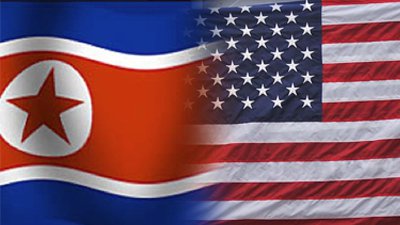Our new administration is at risk if it doesn’t do something about the increasingly elevated tension on the Korean peninsula. North Korea (NK) is an uncontrolled nuclear state with an accelerated missile development program and the Republic of Korea (ROK) just impeached a failed President. Conditions are ripe for something to go terribly wrong. The only moderating voice on the peninsula is Washington’s.
Without hyperbole, it’s safe to say that we are currently seeing with frightening clarity a future we all hoped we could avoid: a rouge regime of Kim Jun-un in North Korea with nukes, an imminent intercontinental ballistic missile (ICBM) capability, and government in Seoul dealing with a constitutional crisis. Reassuringly, the U.S. military is a part of the equation on the peninsula. Realistically, our military may be asked to transition from deterrence to aggression to stop Pyongyang’s wild nuclear ride…a ride designed to strike the United States, not simply North Korea’s regional neighbors.
The U.S.-ROK alliance is steadfast and has been pressure-tested by Pyongyang, North Korea’s capital, and political turmoil in the south multiple times. Precisely because of these challenges, the alliance knows what it is doing.
South Korean democracy has a dark past. It suffered through two military coups in 1961 and 1980 defined by violence, suspension of civil liberties, and restorative calm but always on the edge. In my years watching the peninsula, it always felt like South Korea was a heartbeat away from another political crisis that would push Seoul to the point of anarchy followed by a crushing blow by the military to ensure order.
Well, here we are. Again. Thankfully, order was restored during the impeachment some days ago of President park Geun-hye, not ironically the daughter of General-President Park Chung-hee who led the coup in 1961. The ROK will elect a new President in early May. South Korean democracy is in equal parts emotional and resilient. Kim, not a disinterested observer, will be watching and testing that resilience. It’s something the North Korean regime does quite well but now with even greater consequence. North Korea has nukes! That alters the balance.
Just last week, as the United States and South Korea began their annual “Foal Eagle” joint training exercise, North Korea launched four medium-range ballistic missiles which landed just inside Japan’s Air Defense Identification Zone. This was not a demonstration of new or enhanced missile technology. It was, however, perfectly timed to get maximum attention…always an objective of the regime in Pyongyang.
This past month, Seoul was in political chaos; international media was all over the south covering the increasing vitriol of the South Korean protests; the government was without an effective executive. Of course, North Korea took advantage.
Historically, North Korea is totally dialed into what the U.S.-ROK alliance is up to. Frankly, it’s part of the alliance’s strategy to demonstrate its capabilities and the cost of NK interference. Military exercises in the south are routing. Literally, for decades the alliance has conducted a series of command post exercises and field maneuvers to validate war plans, the evacuation of non-combatants, targeting procedures, and the logistical demands of war in an increasingly dense urban terrain. North Korea has superb human intelligence collection that can hide virtually “in plain sight” in South Korea. That challenges the alliance’s ability to detect and disrupt it, but the upside is the leadership in Seoul knows that North Korea understands the crushing power of the alliance.
Pyongyang knows it cannot challenge the foundation of the alliance in the south. It can, however, have a far moe likely and lasting impact on the peninsula. A nuclear ICBM cannot be ignored. Pyongyang is on a path to realize that capability by 2020 with an arsenal of approximately 100 nuclear tipped ICBMs according to open source intelligence estimates. That’s fare more frightening than another coup in the south and, frankly, more likely.
Time is the only thing slowing this inevitability. For years, the international community has tried every means of pressure to modify North Korea’s behavior in its development of a nuclear capability. Nothing has worked.
There is not enough money to pay off Kim. Economic sanctions do not affect his behavior. His people suffer or starve without result. Kim has advisors and family members killed if there is a suspicion of disloyalty. It’s not lunacy or craziness; it’s total control and survival. Kim wants an equal share internationally of the attention he gets regionally. He wants to be a “playa.” He is now.
So what can be done to stop his march to nuclear infamy? Very simply, Washington has three options: seek China’s help to modify North Korea’s ambitions; diplomatically recognize Pyongyang and end the war on the peninsula (the Korean conflict ended with an armistice); or attach the nuclear missile development capabilities in the north.
These are all legitimately difficult options to realize. Inarguably, China is the only neighbor that North Korea has any historical interest in listening to. However, Beijing’s influence over Pyongyang is diminished. Without Beijing, Pyongyang is further isolated and will result in an acceleration of Pyongyang’s missile and nuclear development. Plus, the U.S. and China must agree that a nuclear North Korea is a threat. Currently, we’re not on the same page.
Recognition of the regime in Pyongyang is a tough nut to crack but may be THE nut that needs cracking. Diplomatic recognition scratches the only political itch that Pyongyang has, which is to be treated like an equal. This option makes me want to throw up in my mouth but the alternative is a nuclear tipped ICBM being launched from North Korea headed toward Alaska or Los Angeles. Though the recently deployed Theater High Altitude Defense (THAAD) system is an effective deterrent from an ICBM or medium-range missile, we should not accept a North Korean regime with these capabilities.
If necessary, the U.S. should act unilaterally to militarily take out North Korea’s nuclear test and missile launch facilities. As abhorrent as it is, a kinetic strike to reduce the nuclear and missile development capabilities of North Korea is legitimate. A military conflict with the north could also lead to one of the worst refugee crisis in our planet’s history. It should be the option of last resort.
The international community can no longer wish away the possibility of a nuclear North Korea. We have used time to our advantage realizing that nuclear and missile technology development in the north was ongoing but remained nascent and not an imminent threat. It is no longer either.
Our ally in Seoul is focused inward to ensure a smooth and democratic transition of power. The U.S. will encourage the Republic of Korea as it exercises its constitutional authorities. Seoul will emerge stronger and our alliance intact. But what about the north?
Time is not our ally here. We have for decades planned for the eventuality. It is upon us.


